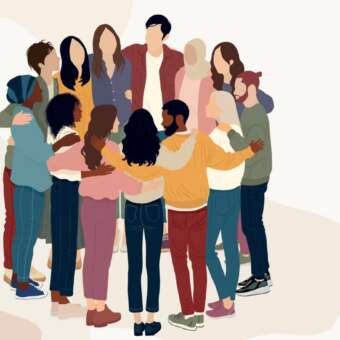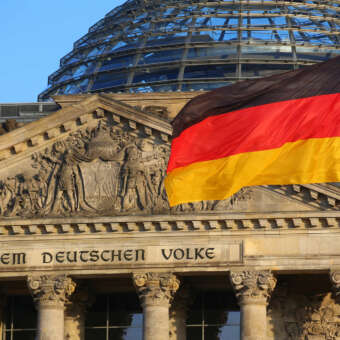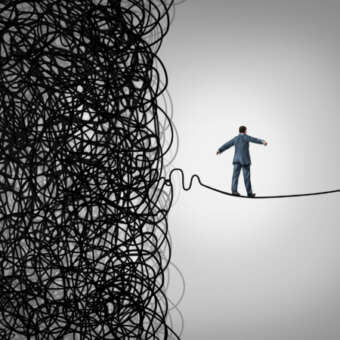"Outdoor clothing is becoming a kind of armor"
Graduate psychologist Birgit Langebartels from the rheingold institute in Cologne talks about the current mood of consumers in Germany, how brands should react to it and why the trend towards nature is unbroken.
The interview appeared in TextilWirtschaft on November 29, 2022.
'We put people in Germany on the couch' is how your institute describes its way of working. You have just published a new study. What is the mood like on the sofas in German living rooms at the moment - especially against the backdrop of the war in Ukraine?
We actually wanted to go out with a new study at the beginning of 2022 on the topic of 'How are people doing after two years of coronavirus? Our idea was that everyone would be waiting in the wings and want to consume, want to go out, want to meet friends. But people were rather melancholic, melancholy. 'To go on a date now or finally celebrate a big birthday this year, I don't know' was often heard. People were doing something like prophylaxis against disappointment. And then the war broke out and we expanded the study to include the question 'How do people experience the war?
With what result?
People went into something like a state of shock. Nobody expected that a war would come so close and take place in Europe. There were very many expressions of solidarity, in very different forms. Here in Cologne, for example, the Shrove Monday parade was canceled and turned into a peace demonstration. This togetherness helped the people.
But such a state of shock is ultimately psychologically impossible to maintain. We have to function somehow. During our survey in May, we saw that people were trying to block out the war as much as possible. People described how they had consumed much, much less news, that they had sometimes gone on a real news freeze and barely followed the war. But of course we also know - and not just as psychologists - that what we suppress is not gone, but continues to have an effect. It was the same with the attempt to suppress the war. We have summarized this in the term 'war tinnitus'. Although the war was repressed, it was still sometimes more or less noticeable.
In the summer, however, one could already get the feeling that the war is no longer taking place at all...
That's right. That was actually so the summer break of the problems. Many people caught up on their celebrations. Round birthdays, which were no longer round, were celebrated. We went on vacation, we enjoyed the beautiful weather. But we somehow already suspected, autumn and winter will not be quite so cozy. However, we saw in our last update in September that the whole crisis with inflation and energy crisis has not yet reached all households.
So the mood is currently better than expected?
We actually already thought that people were wrestling much more with the current situation, but that is by no means the case in every household. What everyone describes, however, is the experience of something very vague. We call it the specter of the vague. It is a crisis of uncertain scope and duration. It's hard to say how hard the crisis will ultimately hit us. Is it just that I might have to put on a warm sweater? Or will the whole economy collapse in winter? Will there be a blackout? Will the relief packages be enough? How much will my electric bill go up? Faced with this uncertainty, we have much less in our hands to do anything about it. And this uncertainty can be felt at various levels, which harbors a very great potential for fear.
What does this mean for consumer behavior?
There are already signs of a split in society, because people are affected to different degrees. Households that have already been close to or even below the subsistence line are currently experiencing an existential impasse. They can no longer save at all, and for them this additional burden is an enormous threat. Others already have to restrict themselves very severely in their everyday lives and have great fears of falling behind. For another group in the population, it is more of a vague threat. They save, but in the end they don't really have to save. But this saving helps them because they get the feeling that 'I can do something about the crisis, I can show solidarity. And then we also have the part of the population that can basically save because they are so well off. We see four different types of crisis perception among the population. Compared to the Corona pandemic, this is a big difference, where the prevailing feeling was that everyone was in the same boat.
What does this differentiation mean for companies?
In any case, saving has a stabilizing and thus important psychological significance. In any case, shopping routines are disrupted. In this context, companies and brands have to ask themselves how they act when people spend less, but they also have to think more carefully about what they spend their money on.
To what extent should companies and brands address the issue in their communications?
It should not be forgotten that people who do not really have to save money are also feeling the effects of the crisis and are therefore also out of step and unsettled. If brands or manufacturers don't respond to this at all, I think that's a very big mistake. Brands must not go underground now, they must be present. It is important that brands address this in their communications, but of course with a positive focus. Basically, brands need to implicitly communicate 'How can I help you get through this crisis?' We have come up with several recommendations for communication. Brands and manufacturers can be transitional helpers.
"It is a crisis of uncertain extent and duration."
Birgit Langebartels
What does that mean in concrete terms?
Presence is important and that consumers feel a sense of reliability à la 'My brand won't leave me alone even in these times'. Transparency is important to show how the brand, the manufacturer, is dealing with the difficulties in these times of crisis. When we advise brands, we take a close look at people's everyday reality. Brands and products have different functions for consumers. Some are more of an everyday companion, others - including fashion - help people get into a different mood. These tend to be psychological mood changers. Companies need to work out exactly which psychological field they serve. This then determines what consumers expect.
What messages are currently particularly important in brand-to-consumer communications?
We see three major themes here: Preserving, stabilizing and encouraging. A preserving message relates more to the past. It tells people, 'You don't have to lose everything you hold dear'. Something remains constant. Persil, for example, has done this well with the 30 degrees campaign. The message is that laundry gets clean even at 30 degrees. Something is changed, but at the same time something is preserved. And that stabilizes people and at the same time legitimizes them to continue using this product or ultimately to turn on the machine and use energy.
This is where the stabilizing aspect comes in. The message must be 'we can help you to stabilize yourself in your everyday life so that you can find your feet again'. The substance remains intact even during the crisis. For example, we have noticed that many people are now turning to private labels for butter, coffee and pasta.
Other brands make it possible to maintain a certain constitution. Take ristorante pizza, for example. If people are now less able to go out to eat, they can create something of a restaurant state of mind at home with this pizza and thus maintain the feeling of 'I'm doing something good for myself'. The latest studies clearly show that it is very important for people to maintain small oases, small moments of well-being in their everyday lives when big expenses such as vacations, going out and culture are no longer possible.
It's always said that a crisis is also an opportunity. Do you also see this as an opportunity for brands at the moment?
It may sound paradoxical, but it certainly applies now. In the current situation, people are putting everything to the test. Now is an enormous opportunity for the brand to present a clear message. Things are being reorganized. People are asking themselves questions such as 'What do I really want to keep for my everyday life?' 'What am I saying goodbye to?' 'What is good for me, what is not so good for me? This is where brands need to show themselves and offer solutions to the crisis. In my opinion, the biggest mistake would be to disappear from the scene, not to communicate or to carry on as before. Because something really has changed. And that's also what consumers tell us in the interviews: 'Yes, I'm cutting back, my everyday life has changed, the crisis is shaking me up. But what are the brands doing?
What should they do?
Send the signal 'We see your need, we see that you have to change'. And to show what they have done themselves and to communicate what they are doing to get through this time well. That's the stabilizing aspect again. Even in the coronavirus era, it has become very clear that regaining self-efficacy and control is extremely important. DIY stores were stormed and people worked, built and gardened. The feeling was conveyed that 'you can create something yourself'. And at the end of the day, at the end of the week after the weekend, you can really look back on your work with pride.
So give courage for new things?
We can all do with a positive outlook for the future. It must be communicated that the crisis has a beginning, but it will also end at some point. Even if we don't really want to believe that at the moment. A crisis also has an end when we have learned to deal with it differently. The term resilience is often used in this context. However, being resilient does not mean that everything is always easy, but that we learn how to deal with difficult situations. Brands and manufacturers can convey this kind of confidence in the future. Take H&M, for example. The company advertises with 'Let's change for tomorrow'. This is a positive view of the future. Brands such as Nivea, Dr. Oetker and Käptn Iglo have already survived many decades and crises, but have remained true to their brand essence and have always adapted to the respective circumstances of society. This conveys stability.
Does this also apply to sports and outdoor brands, which can particularly grab people through experiences and emotions?
In any case. We've seen that especially in the coronavirus era. Outdoors became the better indoors. Outside, the risk of infection was not so great and at the same time, outdoor activities helped people to feel their own self-efficacy. This has strengthened people for the stresses of everyday life. The outdoor clothing is also perceived as a kind of armor. In general, it's exciting how clothing changes the way you feel. In the interviews, we keep hearing 'When I wear this item of clothing, it helps me to become a certain person'.
So the outdoor jacket helps to become a nature lover and hiker?
Not only that. A hike is usually a certain effort, but it's worth it. Because you return to everyday life a bit changed, with the good feeling of having accomplished something and having become a bit stronger. People always describe to us this healing effect of excursions into nature, to feel oneself, to feel the rain on one's skin, to let the wind blow around one's nose, to conquer something oneself, to create something oneself. And I think that will remain, not least because the crisis mode continues. So with that, we will always be able to get back a piece of self-efficacy. And people have also noticed that recreation is right on their doorstep, a vacation very close by, so to speak.
Which outdoor brands do you think play this theme well?
Some brands in this area are currently succeeding in bringing the issue of sustainability to the forefront, for example Patagonia: Consumers also see it as a courtesy on the part of the brand that it is doing something for the environment itself. The offer of repairing clothing is also perceived as a timely response.
The outdoor industry in particular is committed to sustainability. What role does the topic play for people in the current situation?
This positive experience of nature is of course very closely linked to the issue of sustainability. It involves the preservation of nature and thus also something stabilizing. When it comes to the outdoors, we see all three aspects that are so important to people at the moment: The preserving, the stabilizing and the encouraging.
The interview was conducted by Aziza Freutel.




